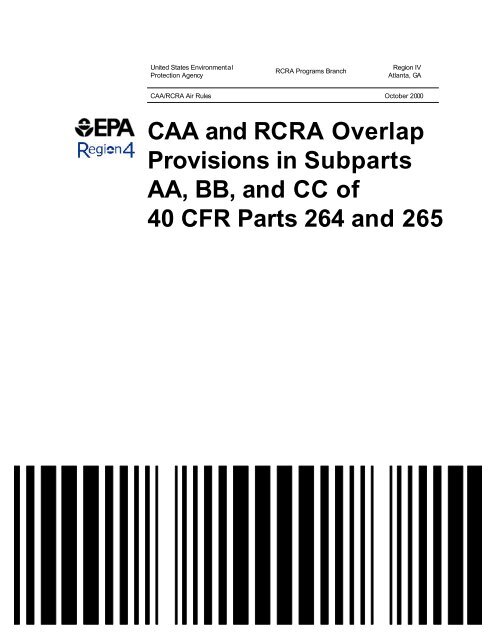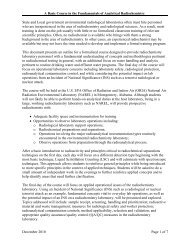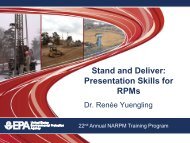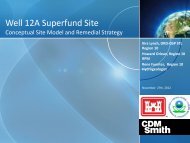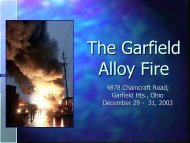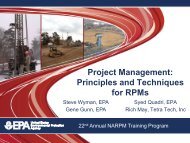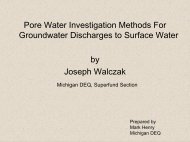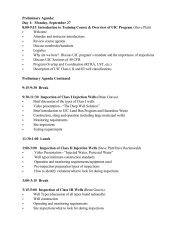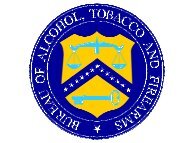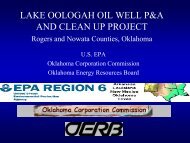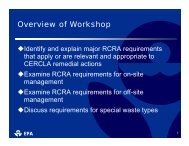CAA and RCRA Overlap Provisions in Subparts AA, BB, and CC of ...
CAA and RCRA Overlap Provisions in Subparts AA, BB, and CC of ...
CAA and RCRA Overlap Provisions in Subparts AA, BB, and CC of ...
- No tags were found...
Create successful ePaper yourself
Turn your PDF publications into a flip-book with our unique Google optimized e-Paper software.
United States EnvironmentalProtection Agency<strong>RCRA</strong> Programs BranchRegion IVAtlanta, GA<strong>C<strong>AA</strong></strong>/<strong>RCRA</strong> Air RulesOctober 2000<strong>C<strong>AA</strong></strong> <strong>and</strong> <strong>RCRA</strong> <strong>Overlap</strong><strong>Provisions</strong> <strong>in</strong> <strong>Subparts</strong><strong>AA</strong>, <strong>BB</strong>, <strong>and</strong> <strong>CC</strong> <strong>of</strong>40 CFR Parts 264 <strong>and</strong> 265
DisclaimerThe <strong>in</strong>formation <strong>in</strong> the document has been funded by the United States EnvironmentalProtection Agency. It has been subjected to EPA’s peer <strong>and</strong> adm<strong>in</strong>istrative review, <strong>and</strong> it hasbeen approved fro publication as an EPA document. Mention <strong>of</strong> trade names or commercialproducts does not constitute endorsement or recommendation fro use by EPA.This document is not <strong>in</strong>tended, nor can it be relied upon, to create any right enforceable byany party <strong>in</strong> litigation with the United States. The EPA may change this document at anytime without public notice.When us<strong>in</strong>g this document, remember that it does not replace any applicable Federalregulations such as the <strong>RCRA</strong> Air Rules <strong>in</strong> <strong>Subparts</strong> <strong>AA</strong>, <strong>BB</strong>, or <strong>CC</strong> <strong>of</strong> 40 CFR part 264 <strong>and</strong>part 265 or any state <strong>and</strong> local rules that may apply to your facility.
This page is <strong>in</strong>tentionally left blank
<strong>C<strong>AA</strong></strong> <strong>and</strong> <strong>RCRA</strong> <strong>Overlap</strong> <strong>Provisions</strong> <strong>in</strong> <strong>Subparts</strong> <strong>AA</strong>, <strong>BB</strong>, <strong>and</strong> <strong>CC</strong> <strong>of</strong> 40 CFR Parts 264 <strong>and</strong> 265Table <strong>of</strong> ContentsSectionPageList <strong>of</strong> Tables ................................................................ viIntroduction .................................................................vii1.0 <strong>RCRA</strong> Air Rules’ <strong>C<strong>AA</strong></strong>/<strong>RCRA</strong> <strong>Overlap</strong> <strong>Provisions</strong> .................................11.1 Subpart <strong>AA</strong>–Air Emission St<strong>and</strong>ards for Process Vents-<strong>C<strong>AA</strong></strong>/<strong>RCRA</strong> <strong>Overlap</strong><strong>Provisions</strong> ........................................................11.1.1 Applicability <strong>and</strong> Exemptions ...................................11.1.2 Technical Requirements .......................................21.2 Subpart <strong>BB</strong>–Air Emission St<strong>and</strong>ards for Equipment Leaks-<strong>C<strong>AA</strong></strong>/<strong>RCRA</strong><strong>Overlap</strong> <strong>Provisions</strong> .................................................41.2.1 Applicability <strong>and</strong> Exemptions ...................................41.2.2 Technical Requirements .......................................61.3 Subpart <strong>CC</strong>–Air Emission St<strong>and</strong>ards for Tanks, Surface Impoundments,<strong>and</strong> Conta<strong>in</strong>ers–<strong>C<strong>AA</strong></strong>/<strong>RCRA</strong> <strong>Overlap</strong> <strong>Provisions</strong> ..........................101.3.1 Applicability <strong>and</strong> Exemptions ..................................101.3.2 Technical Requirements ......................................112.0 <strong>RCRA</strong> Air Rules Recordkeep<strong>in</strong>g Requirements for Clean Air Act Exemptions ..........152.1 Subpart <strong>AA</strong>–Process Vents ..........................................152.2 Subpart <strong>BB</strong>–Equipment Leaks ........................................152.3 Subpart <strong>CC</strong>–Tanks, Conta<strong>in</strong>ers, <strong>and</strong> Surface Impoundments .................152.4 Conclusions ......................................................163.0 Summary <strong>of</strong> Clean Air Act Regulations Applicable to Waste Management Units .......194.0 Clean Air Act Enforceability <strong>and</strong> Operat<strong>in</strong>g Permit Considerations ..................254.1 Facilities With <strong>and</strong> Operat<strong>in</strong>g Permit ..................................254.2 Facilities Without an Operat<strong>in</strong>g Permit .................................284.3 Conclusions ......................................................29v
<strong>C<strong>AA</strong></strong> <strong>and</strong> <strong>RCRA</strong> <strong>Overlap</strong> <strong>Provisions</strong> <strong>in</strong> <strong>Subparts</strong> <strong>AA</strong>, <strong>BB</strong>, <strong>and</strong> <strong>CC</strong> <strong>of</strong> 40 CFR Parts 264 <strong>and</strong> 265TablesNumberPage1.1.2-1 Summary <strong>of</strong> <strong>RCRA</strong> <strong>and</strong> <strong>C<strong>AA</strong></strong> Technical Control Requirements for ProcessVent Control Devices ...............................................41.2.2-1 Summary <strong>of</strong> Equipment Modifications ..................................81.2.2-2 Control Effectiveness for a LDAR Program at a SOCMI Process Unit ...........91.3.2-1 Summary <strong>of</strong> <strong>RCRA</strong> <strong>and</strong> <strong>C<strong>AA</strong></strong> Technical Control Requirements for Tanks,Surface Impoundments, <strong>and</strong> Conta<strong>in</strong>ers ................................143.0-1 Summary <strong>of</strong> <strong>C<strong>AA</strong></strong> Regulations Potentially Applicable to WasteManagement Units ................................................20vi
<strong>C<strong>AA</strong></strong> <strong>and</strong> <strong>RCRA</strong> <strong>Overlap</strong> <strong>Provisions</strong> <strong>in</strong> <strong>Subparts</strong> <strong>AA</strong>, <strong>BB</strong>, <strong>and</strong> <strong>CC</strong> <strong>of</strong> 40 CFR Parts 264 <strong>and</strong> 265IntroductionThe EPA fully recognizes that, <strong>in</strong> develop<strong>in</strong>g air st<strong>and</strong>ards to meet congressionaldirectives established by provisions <strong>in</strong> the Clean Air Act (<strong>C<strong>AA</strong></strong>) <strong>and</strong> Resource Conservation<strong>and</strong> Recovery Act (<strong>RCRA</strong>), the potential exists for regulatory overlap <strong>and</strong> that EPA's<strong>in</strong>tention is to m<strong>in</strong>imize, if not elim<strong>in</strong>ate, regulatory overlap to the extent allowed under thedifferent legislative acts. Section 1006(b) <strong>of</strong> <strong>RCRA</strong> <strong>in</strong>deed requires that the air st<strong>and</strong>ards beconsistent with <strong>and</strong> not duplicative <strong>of</strong> <strong>C<strong>AA</strong></strong> st<strong>and</strong>ards. Similarly, the Clean Air Act voices astrong preference for consistency <strong>of</strong> <strong>C<strong>AA</strong></strong> section 112 st<strong>and</strong>ards <strong>and</strong> <strong>RCRA</strong> st<strong>and</strong>ards wherepracticable (see section 112(n)(7)).The EPA decided that the best way to elim<strong>in</strong>ate any regulatory overlap between the<strong>RCRA</strong> Air Rules <strong>and</strong> the various <strong>C<strong>AA</strong></strong> national emission st<strong>and</strong>ards was to amend the <strong>RCRA</strong>Subpart <strong>AA</strong>, <strong>BB</strong>, <strong>and</strong> <strong>CC</strong> rules to exempt waste management units, process vents, <strong>and</strong>equipment components (otherwise subject to the st<strong>and</strong>ards) that are us<strong>in</strong>g air emissioncontrols <strong>in</strong> accordance with the requirements <strong>of</strong> applicable Clean Air Act new sourceperformance st<strong>and</strong>ard (NSPS) or national emission st<strong>and</strong>ard for hazardous air pollutants(NESHAP) regulations. Therefore, the <strong>RCRA</strong> Air Rules <strong>in</strong> <strong>Subparts</strong> <strong>AA</strong>, <strong>BB</strong>, <strong>and</strong> <strong>CC</strong> <strong>of</strong> part264 <strong>and</strong> part 265 were amended to exempt any hazardous waste management unit that theowner or operator certifies is equipped with <strong>and</strong> operat<strong>in</strong>g air emission controls <strong>in</strong>accordance with an applicable Clean Air Act regulation codified under 40 CFR Part 60, Part61, or Part 63. It is important to note that these exemptions only apply to those units,process vents, or equipment us<strong>in</strong>g organic air emission controls to comply with anapplicable <strong>C<strong>AA</strong></strong> regulation. The EPA has determ<strong>in</strong>ed that this is the best way to assure thatair emissions from hazardous waste management units are controlled to the extent necessaryto protect human health <strong>and</strong> the environment.Provid<strong>in</strong>g this exemption elim<strong>in</strong>ates the possibility <strong>of</strong> duplicative or conflict<strong>in</strong>grequirements for those hazardous waste treatment, storage, <strong>and</strong> disposal facility (TSDF)tanks, surface impoundments, conta<strong>in</strong>ers, process vents, <strong>and</strong> equipment us<strong>in</strong>g organicemission controls <strong>in</strong> compliance with a NSPS or NESHAP under the <strong>C<strong>AA</strong></strong> but also subjectto requirements under the <strong>RCRA</strong> st<strong>and</strong>ards. The Agency considered it unnecessary forowners <strong>and</strong> operators <strong>of</strong> those waste management units subject to air st<strong>and</strong>ards under bothsets <strong>of</strong> rules to perform duplicative test<strong>in</strong>g <strong>and</strong> monitor<strong>in</strong>g, keep duplicative sets <strong>of</strong> records,or perform other duplicative actions. Despite various restrictions <strong>and</strong> conditions that arevii
<strong>C<strong>AA</strong></strong> <strong>and</strong> <strong>RCRA</strong> <strong>Overlap</strong> <strong>Provisions</strong> <strong>in</strong> <strong>Subparts</strong> <strong>AA</strong>, <strong>BB</strong>, <strong>and</strong> <strong>CC</strong> <strong>of</strong> 40 CFR Parts 264 <strong>and</strong> 265<strong>in</strong>cluded <strong>in</strong> the <strong>in</strong>dividual <strong>RCRA</strong> Air Rule subparts, the EPA considers this approach toprovide the facility owner or operator with a broader degree <strong>of</strong> compliance flexibility, <strong>and</strong> aless extensive monitor<strong>in</strong>g, recordkeep<strong>in</strong>g, <strong>and</strong> report<strong>in</strong>g burden under <strong>RCRA</strong>.The purpose <strong>of</strong> this document is to provide the <strong>RCRA</strong> permit writer <strong>and</strong> <strong>in</strong>spectorwith guidance on the appropriate application <strong>of</strong> the <strong>RCRA</strong> Air Rules overlap exemption forfacilities also subject to NSPS <strong>and</strong> NESHAP <strong>and</strong> on how to confirm that the facility ismeet<strong>in</strong>g all requirements under the <strong>C<strong>AA</strong></strong> rules for the units, process vents, <strong>and</strong> equipmentseek<strong>in</strong>g exemptions under the overlap provisions <strong>of</strong> the <strong>RCRA</strong> Air Rules.Section 1.0 <strong>of</strong> this document addresses the <strong>RCRA</strong> Air Rules’ <strong>C<strong>AA</strong></strong>/<strong>RCRA</strong> overlapprovisions. A separate subsection is provided for each <strong>of</strong> the <strong>RCRA</strong> Air Rule subparts, i.e.,Subpart <strong>AA</strong>, Subpart <strong>BB</strong>, <strong>and</strong> Subpart <strong>CC</strong>. Each subsection with<strong>in</strong> Section 1.0 is divided<strong>in</strong>to• a discussion <strong>of</strong> the subpart’s specific applicability <strong>and</strong> exemption provisionswith a discussion <strong>of</strong> the background <strong>of</strong> the exemption <strong>and</strong> any conditionsplaced on the use <strong>of</strong> the exemption presented; <strong>and</strong>• a discussion <strong>of</strong> the technical requirements relative to the air emissioncontrols required by the <strong>RCRA</strong> Air Rules <strong>and</strong> the <strong>C<strong>AA</strong></strong> NSPS <strong>and</strong> NESHAPthat may apply to the facility.Section 2.0 <strong>of</strong> the document addresses the documentation required by the <strong>RCRA</strong> AirRule exemption provisions. A subsection is <strong>in</strong>cluded for each <strong>of</strong> the <strong>RCRA</strong> Air Rulesubparts that notes the documentation required specifically by the relevant subpart. Section3.0 is a summary <strong>of</strong> the <strong>C<strong>AA</strong></strong> regulations that potentially might overlap with the <strong>RCRA</strong> AirRules. Section 4.0 discusses <strong>C<strong>AA</strong></strong> enforceability <strong>and</strong> operat<strong>in</strong>g permit considerations relatedto confirm<strong>in</strong>g that applicable <strong>C<strong>AA</strong></strong> requirements are met for the <strong>RCRA</strong> units, process vents,or equipment that are seek<strong>in</strong>g exemptions under the overlap provisions <strong>of</strong> the <strong>RCRA</strong> AirRules.viii
1.0 <strong>RCRA</strong> Air Rules’ <strong>C<strong>AA</strong></strong>/<strong>RCRA</strong> <strong>Overlap</strong> <strong>Provisions</strong>1.0 <strong>RCRA</strong> Air Rules’ <strong>C<strong>AA</strong></strong>/<strong>RCRA</strong> <strong>Overlap</strong> <strong>Provisions</strong>1.1 Subpart <strong>AA</strong>–Air Emission St<strong>and</strong>ards for Process Vents-<strong>C<strong>AA</strong></strong>/<strong>RCRA</strong><strong>Overlap</strong> <strong>Provisions</strong>1.1.1 Applicability <strong>and</strong> ExemptionsIn the December 8, 1997, revisions to the Subpart <strong>AA</strong> rules (62 FR 64635-64671), theEPA amended §264.1030 <strong>and</strong> §265.1030 (Applicability) to exempt from the requirements <strong>of</strong>Subpart <strong>AA</strong> any “process vents at a facility where the facility owner or operator certifies thatall <strong>of</strong> the process vents that would otherwise be subject to this subpart are equipped with<strong>and</strong> operat<strong>in</strong>g air emission controls <strong>in</strong> accordance with the process vent requirements <strong>of</strong> anapplicable Clean Air Act (<strong>C<strong>AA</strong></strong>) regulation codified under 40 CFR Part 60, Part 61, or Part63.”The EPA amended the applicability provision <strong>of</strong> Subpart <strong>AA</strong> by add<strong>in</strong>g a new§264.1030(e) <strong>and</strong> §265.1030(d). This provision states that a process vent is not subject to theSubpart <strong>AA</strong> st<strong>and</strong>ards provided the owner or operator certifies that all Subpart<strong>AA</strong>-regulated process vents at the facility are equipped with <strong>and</strong> operat<strong>in</strong>g air emissioncontrols <strong>in</strong> accordance with the requirements <strong>of</strong> an applicable Clean Air Act regulationcodified <strong>in</strong> Part 60, 61, or 63. This provision is quite similar to but not exactly the same asthe one adopted by EPA for units subject to Subpart <strong>CC</strong> as part <strong>of</strong> the November 1996amendments (see §264.1080(d) <strong>and</strong> §265.1080(d) <strong>of</strong> Subpart <strong>CC</strong>) <strong>and</strong> the logic for apply<strong>in</strong>gthe exemption <strong>in</strong> much the same manner to Subpart <strong>AA</strong> process vents is identical to therationale used by EPA for the Subpart <strong>CC</strong> revisions.The Subpart <strong>AA</strong> process vent applicability exemption is, however, implementedslightly differently from the parallel exemption for Subpart <strong>CC</strong> units. Both complianceapproaches allowed under the exist<strong>in</strong>g Subpart <strong>AA</strong> rules require emission control oremission limits on a facility-wide basis. See the provisions at 40 CFR 264.1032(a)(1) <strong>and</strong>(a)(2). Thus, to be equally protective <strong>of</strong> human health <strong>and</strong> the environment, the EPAconsidered it necessary that any alternative compliance demonstration require control <strong>of</strong> all1
1.0 <strong>RCRA</strong> Air Rules’ <strong>C<strong>AA</strong></strong>/<strong>RCRA</strong> <strong>Overlap</strong> <strong>Provisions</strong><strong>of</strong> the process vents at the facility that would have otherwise been regulated under Subpart<strong>AA</strong>. Therefore, the Subpart <strong>AA</strong> process vent applicability exemption is only available at afacility where each <strong>and</strong> every process vent that would otherwise be subject to Subpart <strong>AA</strong> isequipped with <strong>and</strong> operat<strong>in</strong>g air emission controls <strong>in</strong> compliance with an applicable <strong>C<strong>AA</strong></strong>st<strong>and</strong>ard under Part 60, 61, or 63. The various <strong>in</strong>dividual vents could be regulated underdifferent <strong>C<strong>AA</strong></strong> rules as long as all vents (otherwise subject to Subpart <strong>AA</strong>) are controlledunder an applicable <strong>C<strong>AA</strong></strong> rule.As with the similar exemption provisions <strong>in</strong> <strong>Subparts</strong> <strong>BB</strong> <strong>and</strong> <strong>CC</strong>, to comply withthe requirements at paragraphs §264.1030(e) or§265.1030(d) <strong>and</strong> thus qualify for theapplicability exemption, the emissions from each Subpart <strong>AA</strong> process vent must be routedthrough a closed-vent system to an air emission control device. A process vent that is <strong>in</strong>compliance with a <strong>C<strong>AA</strong></strong> st<strong>and</strong>ard under an exemption from control requirements (i.e., is notequipped with <strong>and</strong> operat<strong>in</strong>g a control device) does not meet the criteria established <strong>in</strong> theprovisions paragraph §264.1030(e) or §265.1030(d) <strong>of</strong> Subpart <strong>AA</strong>. Therefore, a unit thatdoes not use the required air emission controls but is <strong>in</strong> compliance with a NESHAPthrough an “emission averag<strong>in</strong>g” or “bubbl<strong>in</strong>g” provision does not qualify for the exemption.Similarly, if the Clean Air Act st<strong>and</strong>ard for the particular unit is no control (for example,because the Maximum Achievable Control Technology (MACT) floor for the source categoryis no control <strong>and</strong> the Agency decided not to apply controls more str<strong>in</strong>gent than the floor),the exemption from the <strong>RCRA</strong> st<strong>and</strong>ards under §264.1030(e) or §265.1030(d) <strong>of</strong> Subpart <strong>AA</strong>would not apply s<strong>in</strong>ce the unit would not actually be controlled (i.e., equipped <strong>and</strong>operat<strong>in</strong>g air emission controls) under provisions <strong>of</strong> the MACT st<strong>and</strong>ard.To take the above example a step further, at a facility where all but one <strong>of</strong> theSubpart <strong>AA</strong> process vents are equipped with air emission controls for compliance under<strong>C<strong>AA</strong></strong> rules <strong>and</strong> the one uncontrolled Subpart <strong>AA</strong> process vent is also <strong>in</strong> compliance with a<strong>C<strong>AA</strong></strong> regulation but is not controlled for air emissions, the facility’s Subpart <strong>AA</strong> processvents do not meet the applicability exemption criteria as stated <strong>in</strong> Subpart <strong>AA</strong> <strong>and</strong> thus arenot exempt from the rule under §264.1030(e) or §265.1030(d). Despite this restriction, theEPA considers this alternative to provide the facility owner or operator with a broaderdegree <strong>of</strong> compliance flexibility, <strong>and</strong> less extensive monitor<strong>in</strong>g, recordkeep<strong>in</strong>g, <strong>and</strong>report<strong>in</strong>g requirements under <strong>RCRA</strong>.1.1.2 Technical RequirementsThe regulatory language used <strong>in</strong> the applicability exclusion under §264.1030(e) <strong>and</strong>§265.1030(d) does not condition the use <strong>of</strong> the Subpart <strong>AA</strong> <strong>RCRA</strong>/<strong>C<strong>AA</strong></strong> overlap exemptionon the relative str<strong>in</strong>gency <strong>of</strong> the <strong>C<strong>AA</strong></strong> rule under which the process vents are required to2
1.0 <strong>RCRA</strong> Air Rules’ <strong>C<strong>AA</strong></strong>/<strong>RCRA</strong> <strong>Overlap</strong> <strong>Provisions</strong><strong>in</strong>stall <strong>and</strong> operate air emission controls. No mention is made <strong>of</strong> relative str<strong>in</strong>gency <strong>in</strong> therule language. Therefore, the Subpart <strong>AA</strong> applicability exclusion <strong>in</strong> paragraphs (e) <strong>and</strong> (d)does not require that the <strong>C<strong>AA</strong></strong> air emission controls be equivalent or more str<strong>in</strong>gent than thecontrol device requirements under Subpart <strong>AA</strong> for the affected waste management unitprocess vent. Language regard<strong>in</strong>g the relative str<strong>in</strong>gency <strong>of</strong> the various rules under which aprocess vent on a waste management unit could be required to <strong>in</strong>stall air emission controlswas not considered necessary or mean<strong>in</strong>gful relative to control <strong>of</strong> waste management unitprocess vents; this is because the technical control requirements prescribed <strong>in</strong> the variousrules for these waste management unit process vents are for all practical purposes the same.Therefore, implementation <strong>of</strong> vent controls, regardless <strong>of</strong> what particular rule the controlsare required under, results <strong>in</strong> approximately the same overall level <strong>of</strong> control deviceperformance for the vent stream.A review <strong>of</strong> the regulations affect<strong>in</strong>g waste management unit process vents showsthat the technical control requirements for process vents are relatively consistent withregard to control device performance. For the most part, both the <strong>RCRA</strong> <strong>and</strong> <strong>C<strong>AA</strong></strong> rules forprocess vents require use (i.e., <strong>in</strong>stallation <strong>and</strong> operation) <strong>of</strong> a control device on the ventunless certa<strong>in</strong> source category or rule specific criteria are met. For example, if the waste hasan organic constituent concentration below a specified level or the vent flow <strong>and</strong>concentration are below stated dim<strong>in</strong>imus values controls are not required. For the Subpart<strong>AA</strong> process vent rules <strong>in</strong> parts 264 <strong>and</strong> 265, the rules apply to specific unit operations thatare manag<strong>in</strong>g hazardous wastes with organic concentrations <strong>of</strong> at least 10 ppmw. For the<strong>of</strong>f-site waste <strong>and</strong> recovery operations NESHAP <strong>in</strong> part 63, the applicability criteria <strong>in</strong>cludea 500 ppmw Volatile Organic Hazardous Air Pollutant (VOHAP) concentration <strong>in</strong> the <strong>of</strong>fsitematerial managed <strong>in</strong> the unit on which the process vent is located. The <strong>of</strong>f-site waste<strong>and</strong> recovery NESHAP also has process vent flow <strong>and</strong> concentration criteria <strong>of</strong> 6 m 3 /m<strong>in</strong> <strong>and</strong>20 ppmv for the vent stream. Part 63 <strong>in</strong> the HON also has flow rate <strong>and</strong> concentrationcriteria (0.005 scm/m<strong>in</strong> <strong>and</strong> 50 ppmv total organic HAP concentration) that are used tocategorize process vents for application <strong>of</strong> control devices. The rules, <strong>in</strong> general, requirethat the control device meet certa<strong>in</strong> design, operational, <strong>and</strong> performance criteria <strong>and</strong> it isthese control device technical requirements that are similar throughout the <strong>RCRA</strong> <strong>and</strong> <strong>C<strong>AA</strong></strong>process vent rules. These performance or technical requirements are briefly summarized <strong>in</strong>Table 1.2.1-1.3
1.0 <strong>RCRA</strong> Air Rules’ <strong>C<strong>AA</strong></strong>/<strong>RCRA</strong> <strong>Overlap</strong> <strong>Provisions</strong>1.2 Subpart <strong>BB</strong>–Air Emission St<strong>and</strong>ards for Equipment Leaks-<strong>C<strong>AA</strong></strong>/<strong>RCRA</strong> <strong>Overlap</strong> <strong>Provisions</strong>1.2.1 Applicability <strong>and</strong> ExemptionsCompliance with EPA equipment leak st<strong>and</strong>ards is typically assessed through review<strong>of</strong> records that document implementation <strong>of</strong> the technical requirements <strong>of</strong> the rule. Asorig<strong>in</strong>ally promulgated (55 FR 25506, June 21, 1990), the Subpart <strong>BB</strong> recordkeep<strong>in</strong>g <strong>and</strong>report<strong>in</strong>g requirements at §264.1064(m) <strong>and</strong> §265.1064(m) provided that “the owner oroperator <strong>of</strong> any facility that is subject to this subpart (i.e., Subpart <strong>BB</strong>) <strong>and</strong> to regulations at40 CFR Part 60, Subpart VV, or 40 CFR Part 61, Subpart V, may elect to determ<strong>in</strong>ecompliance with this subpart (i.e., Subpart <strong>BB</strong>) by documentation either pursuant to§264.1064 <strong>of</strong> this subpart, or pursuant to those provisions <strong>of</strong> 40 CFR Part 60 or 61, to theTable 1.2.1-1.Summary <strong>of</strong> <strong>RCRA</strong> <strong>and</strong> <strong>C<strong>AA</strong></strong> Technical Control Requirements forProcess Vent Control DevicesControl Device TypeEnclosed combustion devises(e.g., thermal <strong>in</strong>c<strong>in</strong>erator, catalytic<strong>in</strong>c<strong>in</strong>erator, boiler, or process heater)Control Device Technical RequirementsTechnical Control Requirement• 95 % destruction efficiency• 20 ppmv exit concentration• m<strong>in</strong>imum residence <strong>and</strong> temperature,(e.g., 760 o C <strong>and</strong> 0.5 sec)Recovery devices(e.g., carbon adsorber or condenser)Flares• 95 % overall recovery• design <strong>and</strong> operational criteria(e.g., no visible emissions)extent that the documentation under the regulation at 40 CFR Part 60 or 61 duplicates thedocumentation required under this subpart (i.e., Subpart <strong>BB</strong>).” The purpose <strong>of</strong> thisparagraph <strong>in</strong> Subpart <strong>BB</strong> was to add a provision <strong>in</strong> the rule to provide for elim<strong>in</strong>ation <strong>of</strong>recordkeep<strong>in</strong>g requirements that are duplicative <strong>of</strong> other Federal requirements forequipment leaks.The amendments to the Subpart <strong>BB</strong> rules, published on December 8, 1997 (62 FR4
1.0 <strong>RCRA</strong> Air Rules’ <strong>C<strong>AA</strong></strong>/<strong>RCRA</strong> <strong>Overlap</strong> <strong>Provisions</strong>64636-64671), revised the recordkeep<strong>in</strong>g provisions <strong>of</strong> Subpart <strong>BB</strong> to elim<strong>in</strong>ate owner oroperator burden caused by regulatory overlap <strong>of</strong> the various EPA equipment leak regulationsunder the Clean Air Act <strong>and</strong> <strong>RCRA</strong>. The Subpart <strong>BB</strong> recordkeep<strong>in</strong>g provisions <strong>in</strong> Section264.1064(m) <strong>and</strong> Sec. 265.1064(m) were amended to allow any equipment that conta<strong>in</strong>s orcontacts hazardous waste that is subject to Subpart <strong>BB</strong> <strong>and</strong> also subject to regulations <strong>in</strong>40 CFR Part 60, 61, or 63 to determ<strong>in</strong>e compliance with Subpart <strong>BB</strong> by documentation <strong>of</strong>compliance with the relevant provisions <strong>of</strong> the Clean Air Act rules codified under 40 CFRPart 60, Part 61, or Part 63. As noted <strong>in</strong> the preamble to these amendments, “becausecompliance with Subpart <strong>BB</strong> is demonstrated through recordkeep<strong>in</strong>g, this recordkeep<strong>in</strong>grevision has the effect <strong>of</strong> exempt<strong>in</strong>g equipment that would otherwise be subject toSubpart <strong>BB</strong> from Subpart <strong>BB</strong> requirements, provided the equipment is operated, monitored,<strong>and</strong> repaired <strong>in</strong> accordance with an applicable <strong>C<strong>AA</strong></strong> st<strong>and</strong>ard, <strong>and</strong> appropriate records arekept to that effect.”Paragraph §264.1064 (m) <strong>in</strong> the recordkeep<strong>in</strong>g requirements states that the owner oroperator “...may elect to determ<strong>in</strong>e compliance with this subpart either by documentationpursuant to §264.1064 <strong>of</strong> this subpart [i.e., Subpart <strong>BB</strong>], or by documentation <strong>of</strong> compliancewith the regulations at 40 CFR Part 60, Part 61, or Part 63 pursuant to the relevantprovisions <strong>of</strong> the regulations at 40 CFR Part 60, Part 61, or Part 63.” The correspond<strong>in</strong>g Part265 language is the same. The objective <strong>of</strong> the amendment was to elim<strong>in</strong>ate any owner oroperator burden caused by regulatory overlap. In mak<strong>in</strong>g the revision to paragraph (m) <strong>in</strong>§264.1064 <strong>and</strong> §265.1064 <strong>of</strong> Subpart <strong>BB</strong>, the Agency <strong>in</strong>tended that, for a piece <strong>of</strong> equipmentsubject to equipment leak regulations under the <strong>C<strong>AA</strong></strong> as well as <strong>RCRA</strong> Subpart <strong>BB</strong>,compliance with the <strong>C<strong>AA</strong></strong> rules rather than the <strong>RCRA</strong> Subpart <strong>BB</strong> requirements would be anadequate demonstration <strong>of</strong> compliance <strong>and</strong> <strong>in</strong> effect elim<strong>in</strong>ate the need to demonstratecompliance under Subpart <strong>BB</strong> <strong>of</strong> the <strong>RCRA</strong> Air Rules. The provisions <strong>in</strong> 40 CFR264.1064(m) <strong>and</strong> 265.1064(m) are <strong>in</strong>tended to allow a facility owner or operator todemonstrate compliance with all <strong>of</strong> subpart <strong>BB</strong>, through documentation <strong>of</strong> compliance withregulations under one <strong>of</strong> the specified parts <strong>of</strong> the <strong>C<strong>AA</strong></strong>. Simply put, if a facility hasequipment that is subject to relevant provisions (i.e., provisions for operat<strong>in</strong>g, monitor<strong>in</strong>g,<strong>and</strong> repair<strong>in</strong>g subpart <strong>BB</strong> equipment) under regulations with<strong>in</strong> the specified <strong>C<strong>AA</strong></strong> parts, thatequipment is exempt from 40 CFR part 264 subpart <strong>BB</strong>. To be eligible for the exemptionprovided by 40 CFR 264.1064(m) or 265.1064(m): the relevant <strong>C<strong>AA</strong></strong> requirements must beapplicable to the subpart <strong>BB</strong> equipment; the relevant <strong>C<strong>AA</strong></strong> requirements must <strong>in</strong>cludeprovisions for operation, monitor<strong>in</strong>g, <strong>and</strong> repair <strong>of</strong> the Subpart <strong>BB</strong> equipment; the relevant5
1.0 <strong>RCRA</strong> Air Rules’ <strong>C<strong>AA</strong></strong>/<strong>RCRA</strong> <strong>Overlap</strong> <strong>Provisions</strong><strong>C<strong>AA</strong></strong> requirements must be codified with<strong>in</strong> 40 CFR part 60, 61, or 63; <strong>and</strong> compliance withthe relevant <strong>C<strong>AA</strong></strong> requirements must be documented <strong>in</strong> the facility operat<strong>in</strong>g record.1.2.2 Technical RequirementsThe regulatory language used <strong>in</strong> the revised paragraph (m) <strong>of</strong> Subpart <strong>BB</strong> does notcondition the use <strong>of</strong> the <strong>C<strong>AA</strong></strong> documentation <strong>of</strong> compliance <strong>in</strong> place <strong>of</strong> Subpart <strong>BB</strong>compliance on the relative str<strong>in</strong>gency <strong>of</strong> the rule be<strong>in</strong>g used to document compliance. Nomention is made <strong>of</strong> relative str<strong>in</strong>gency <strong>in</strong> the rule language. That is, Subpart <strong>BB</strong>paragraph (m) does not require that the alternative <strong>C<strong>AA</strong></strong> equipment leak rule be equivalent toor more str<strong>in</strong>gent than the control requirements <strong>of</strong> Subpart <strong>BB</strong>. This type <strong>of</strong> rule languagewas not considered necessary or mean<strong>in</strong>gful <strong>in</strong> relation to the Agency’s equipment leakst<strong>and</strong>ards because differences <strong>in</strong> the various <strong>C<strong>AA</strong></strong> <strong>and</strong> <strong>RCRA</strong> equipment leak rules <strong>in</strong> terms<strong>of</strong> technical requirements <strong>and</strong> overall control performance are marg<strong>in</strong>al.The EPA has promulgated a number <strong>of</strong> equipment leak regulations <strong>in</strong> 40 CFR Part 60,Part 61, <strong>and</strong> Part 63; although these rules may vary somewhat <strong>in</strong> format <strong>and</strong> adm<strong>in</strong>istrativerequirements, they conta<strong>in</strong> nearly the same technical requirements (<strong>in</strong> terms <strong>of</strong> performance,work practice, <strong>and</strong> equipment requirements) <strong>and</strong> achieve approximately the same level <strong>of</strong>emissions control for the majority <strong>of</strong> equipment component types. For pumps <strong>and</strong> valves,there are differences <strong>in</strong> estimated control efficiencies that result from the use <strong>of</strong> differentleak def<strong>in</strong>itions <strong>and</strong> monitor<strong>in</strong>g frequencies <strong>and</strong>, as a result, compliance with one <strong>of</strong> theseequipment leak rules over another does result <strong>in</strong> slightly different emission reductions.However, the <strong>in</strong>cremental emission reductions are small. The technical requirementscover<strong>in</strong>g other equipment components (e.g., sampl<strong>in</strong>g connections <strong>and</strong> open-ended l<strong>in</strong>es)are the same <strong>in</strong> all the rules.With regard to the control efficiencies for equipment leak control techniques, thereare two primary techniques for reduc<strong>in</strong>g equipment leak emissions that form the basis <strong>of</strong>exist<strong>in</strong>g EPA regulations: 1) modify<strong>in</strong>g or replac<strong>in</strong>g exist<strong>in</strong>g equipment, <strong>and</strong> 2)implement<strong>in</strong>g a leak detection <strong>and</strong> repair (LDAR) program. Table 1.2.2-1 presents asummary <strong>of</strong> equipment modifications that can be used for each equipment type with anapproximate control efficiency for each modification. The equipment requirements (e.g.,<strong>in</strong>stall<strong>in</strong>g caps on open-ended l<strong>in</strong>es or <strong>in</strong>stall<strong>in</strong>g closed-loop sampl<strong>in</strong>g systems) areessentially the same <strong>in</strong> all <strong>of</strong> the Agency’s equipment leak rules; therefore there are no realdifferences <strong>in</strong> rule str<strong>in</strong>gency for these equipment types.The LDAR program is a structured program to detect <strong>and</strong> repair equipment that isidentified as leak<strong>in</strong>g (i.e., emitt<strong>in</strong>g sufficient amounts <strong>of</strong> regulated material to warrantreduction <strong>of</strong> the emissions through repair); a portable monitor<strong>in</strong>g device is used to identify6
1.0 <strong>RCRA</strong> Air Rules’ <strong>C<strong>AA</strong></strong>/<strong>RCRA</strong> <strong>Overlap</strong> <strong>Provisions</strong>equipment leaks from <strong>in</strong>dividual pieces <strong>of</strong> equipment. LDAR programs are best suited tovalves <strong>and</strong> pumps. The control effectiveness <strong>of</strong> any given LDAR program is dependent on anumber <strong>of</strong> factors <strong>in</strong>clud<strong>in</strong>g leak def<strong>in</strong>ition <strong>and</strong> monitor<strong>in</strong>g frequency as well as <strong>in</strong>itial <strong>and</strong>f<strong>in</strong>al leak frequencies. The exist<strong>in</strong>g EPA equipment leak rules vary <strong>in</strong> a number <strong>of</strong> ways thatrelate to these program factors. Some formats specify the leak def<strong>in</strong>ition (e.g., 10,000 ppmv)<strong>and</strong> monitor<strong>in</strong>g frequency (e.g., monthly or quarterly) <strong>and</strong> others specify the f<strong>in</strong>al leakfrequency. The EPA has estimated the differences <strong>in</strong> control effectiveness at SyntheticOrganic Chemical Manufactur<strong>in</strong>g Industry (SOCMI) process units for typical LDARprograms that are <strong>in</strong> the 40 CFR Part 60, Part 61, <strong>and</strong> Part 63 equipment leak rules. These<strong>in</strong>clude: 1) monthly LDAR with a leak def<strong>in</strong>ition <strong>of</strong> 10,000 ppmv, similar to therequirements <strong>of</strong> Subpart <strong>BB</strong> <strong>of</strong> Parts 264 <strong>and</strong> 265, Subpart VV <strong>and</strong> Subpart GGG <strong>of</strong> part 60,<strong>and</strong> Subpart VV <strong>and</strong> Subpart J <strong>in</strong> Part 61; 2) LDAR equivalent to that specified <strong>in</strong> thehazardous organic NESHAP (or HON) <strong>in</strong> Subpart H <strong>of</strong> Part 63 that has a lower leakdef<strong>in</strong>ition for pumps <strong>and</strong> valves (e.g., 500 ppmv for Phase II <strong>and</strong> III) <strong>and</strong> specifies themonitor<strong>in</strong>g frequency based on the leak frequency. Table 1.2.2-2 summarizes the estimatedcontrol effectiveness for the two LDAR programs at SOCMI process units, which also werethose used <strong>in</strong> the orig<strong>in</strong>al Subpart <strong>BB</strong> analysis to characterize waste management unitequipment leak emissions. As the estimates <strong>in</strong> Tables 1.2.2-1 <strong>and</strong> 1.2.2-2 show, thedifferences <strong>in</strong> emission reductions achieved by the various equipment leak rules arem<strong>in</strong>imal.The fact that EPA <strong>in</strong>tended to keep all the various equipment leak rules consistent (ifnot equivalent) is shown by the preamble language that describes the changes made to theSubpart <strong>BB</strong> rules <strong>in</strong> the November 25, 1996, Federal Register notice (61 FR 59937). In thesechanges, the EPA <strong>in</strong>corporated <strong>in</strong>to the Subpart <strong>BB</strong> st<strong>and</strong>ards recent changes that were madeto other national equipment st<strong>and</strong>ards that require equipment leak detection <strong>and</strong> repairprograms. Revisions to the <strong>RCRA</strong> st<strong>and</strong>ards for equipment leaks consist <strong>of</strong> <strong>in</strong>corporat<strong>in</strong>gchanges to the requirements so that the Subpart <strong>BB</strong> requirements <strong>in</strong> Parts 264 <strong>and</strong> 265 areconsistent <strong>and</strong> up-to-date with the general decisions the EPA has made regard<strong>in</strong>g leakdetection <strong>and</strong> repair program requirements for organic air emission control <strong>in</strong> otherregulations under the Clean Air Act (e.g., National Emission St<strong>and</strong>ards for Hazardous AirPollutants (NESHAP): Off-Site Waste <strong>and</strong> Recovery Operations, 61 FR 34140, July 1, 1996,or the National Emission St<strong>and</strong>ards for Organic Hazardous Air Pollutants for EquipmentLeaks, 40 CFR Part 63, Subpart H, 59 FR 19402, April 22, 1994, i.e., the HON).7
1.0 <strong>RCRA</strong> Air Rules’ <strong>C<strong>AA</strong></strong>/<strong>RCRA</strong> <strong>Overlap</strong> <strong>Provisions</strong>Table 1.2.2-1. Summary <strong>of</strong> Equipment ModificationsEquipment typeModificationApproximate controlefficiency (%)PumpsCompressorsPressure relief devicesSealless designClosed-vent systemDual mechanical seal with barrier fluidma<strong>in</strong>ta<strong>in</strong>ed at a higher pressure than thepumped fluidClosed-vent systemDual mechanical seal with barrier fluidma<strong>in</strong>ta<strong>in</strong>ed at a higher pressure than thecompressed gasClosed-vent systemRupture disk assembly100 a90 b10090 b100c100Valves Sealless design 100 aConnectors Weld together 100Open-ended l<strong>in</strong>es Bl<strong>in</strong>d, cap, plug, or second valve 100Sampl<strong>in</strong>g connections Closed-loop sampl<strong>in</strong>g 100abcSealless equipment can be a large source <strong>of</strong> emissions <strong>in</strong> the event <strong>of</strong> equipment failure.Actual efficiency <strong>of</strong> a closed-vent system depends on percentage <strong>of</strong> vapors collected <strong>and</strong> efficiency <strong>of</strong> controldevice to which the vapors are routed.Control efficiency <strong>of</strong> closed vent-systems <strong>in</strong>stalled on a pressure relief device may be lower than other closed-ventsystems, because they must be designed to h<strong>and</strong>le both potentially large <strong>and</strong> small volumes <strong>of</strong> vapor.8
1.0 <strong>RCRA</strong> Air Rules’ <strong>C<strong>AA</strong></strong>/<strong>RCRA</strong> <strong>Overlap</strong> <strong>Provisions</strong>Table 1.2.2-2. Control Effectiveness for a LDAR Program at a SOCMI Process UnitControl effectiveness (%)Equipment type <strong>and</strong> serviceMonthly monitor<strong>in</strong>g a10,000 ppmv leak def<strong>in</strong>ition HON bValves - gas 87 92Valves - light liquid 84 88Pumps - light liquid 69 75abThis format serves as the basis for the 40 CFR Part 60 <strong>and</strong> Part 61 <strong>C<strong>AA</strong></strong> equipment leak regulations as well as the<strong>RCRA</strong> Subpart <strong>BB</strong> rules.Control effectiveness attributable to the requirements <strong>of</strong> the hazardous organic NESHAP equipment leaknegotiated regulation, 63 CFR Subpart H, are estimated based on equipment-specific leak def<strong>in</strong>itions <strong>and</strong>performance levels specified <strong>in</strong> Subpart H.9
1.0 <strong>RCRA</strong> Air Rules’ <strong>C<strong>AA</strong></strong>/<strong>RCRA</strong> <strong>Overlap</strong> <strong>Provisions</strong>1.3 Subpart <strong>CC</strong>–Air Emission St<strong>and</strong>ards for Tanks, SurfaceImpoundments, <strong>and</strong> Conta<strong>in</strong>ers–<strong>C<strong>AA</strong></strong>/<strong>RCRA</strong> <strong>Overlap</strong> <strong>Provisions</strong>1.3.1 Applicability <strong>and</strong> ExemptionsIn the November 25, 1996, revisions to the Subpart <strong>CC</strong> rules (61 FR 59932 - 59997),the EPA amended paragraph (b)(7) <strong>of</strong> §264.1080 <strong>and</strong> §265.1080 (Applicability) to exemptfrom the requirements <strong>of</strong> Subpart <strong>CC</strong> any “hazardous waste management unit that the owneror operator certifies is equipped with <strong>and</strong> operat<strong>in</strong>g air emission controls <strong>in</strong> accordancewith an applicable Clean Air Act (<strong>C<strong>AA</strong></strong>) regulation codified under 40 CFR Part 60, Part 61, orPart 63.”There are three limitations to this applicability exemption that are expla<strong>in</strong>ed <strong>in</strong> thepreamble to the Subpart <strong>CC</strong> revisions. First, for a tank that uses an enclosure as a part <strong>of</strong> theair emission control system rather than the more conventional tank controls <strong>in</strong>volv<strong>in</strong>gcovers, the enclosure <strong>and</strong> control device used must comply with the technical requirementsfor enclosures <strong>and</strong> combustion devices <strong>in</strong> §264.1084(i). If this is the case then the unit isexempt from further requirements under the rule. This enclosure/control device limitationdoes not hold if the tank is located <strong>in</strong>side an enclosure vented to a control device that isdesigned <strong>and</strong> operated <strong>in</strong> accordance with all the applicable requirements specified under40 CFR Part 61, Subpart FF—National Emission St<strong>and</strong>ards for Benzene Waste Operations,as is noted directly <strong>in</strong> paragraph (b)(7) <strong>of</strong> §264.1080 <strong>and</strong> §265.1080. These benzene wastetanks are exempt from Subpart <strong>CC</strong> as long as they meet the Part 61 Subpart FF requirementsapplicable to the unit.Second, a unit that does not use the required air emission controls but is <strong>in</strong>compliance with a NESHAP through an “emission averag<strong>in</strong>g” or “bubbl<strong>in</strong>g” provision doesnot qualify for the exemption; EPA lacks assurance that emissions from the unit arecontrolled to the extent necessary to protect human health <strong>and</strong> the environment. Anexplanation for this limitation was provided <strong>in</strong> footnote 2 <strong>of</strong> the preamble at 61 FR 59939,November 25, 1996.10
1.0 <strong>RCRA</strong> Air Rules’ <strong>C<strong>AA</strong></strong>/<strong>RCRA</strong> <strong>Overlap</strong> <strong>Provisions</strong>Third, if the Clean Air Act st<strong>and</strong>ard for the particular unit requires no control, theexemption from the <strong>RCRA</strong> st<strong>and</strong>ards under §264.1080(b)(7) would not apply s<strong>in</strong>ce the unitwould not actually be equipped <strong>and</strong> operat<strong>in</strong>g air emission controls under provisions <strong>of</strong> theMACT st<strong>and</strong>ard. Aga<strong>in</strong>, as stated above, the EPA believes the best way to assureprotectiveness under the Subpart <strong>CC</strong> national rule is to require controls on each particularunit. It is therefore clearly EPA’s <strong>in</strong>tent that for a hazardous waste management unit to takeadvantage <strong>of</strong> this Subpart <strong>CC</strong> applicability exemption, the particular unit must be equippedwith <strong>and</strong> operat<strong>in</strong>g air emission controls under an applicable <strong>C<strong>AA</strong></strong> regulation.The EPA further expla<strong>in</strong>ed <strong>in</strong> the November 1996 preamble their logic <strong>and</strong> rationalefor <strong>in</strong>clud<strong>in</strong>g this particular exclusion <strong>in</strong> the Subpart <strong>CC</strong> rules. In short, the Agency foundthat where there are MACT air emission control requirements for a specific unit otherwisecovered by Subpart <strong>CC</strong>, the MACT typically requires the same technical air emissioncontrols as would be required under Subpart <strong>CC</strong>. Thus, it follows that compliance with theMACT requirements (such that the unit is equipped with <strong>and</strong> operat<strong>in</strong>g air emissioncontrols) would thus afford equal protectiveness as would be achieved under Subpart <strong>CC</strong>,<strong>and</strong> therefore can be considered to satisfy the <strong>RCRA</strong> protectiveness requirements.1.3.2 Technical RequirementsThe technical requirements for the <strong>RCRA</strong> Air Rules <strong>in</strong> Subpart <strong>CC</strong> as amended areessentially the same as those published by the EPA under the <strong>C<strong>AA</strong></strong> section 112 MACTprogram. A unit controlled under one or the other set <strong>of</strong> requirements would achieve thesame emission reduction <strong>and</strong> performance level; <strong>and</strong> the various requirements thus providethe same level <strong>of</strong> protection. For example, EPA, <strong>in</strong> promulgat<strong>in</strong>g the f<strong>in</strong>al requirements forthe Off-Site Waste <strong>and</strong> Recovery Operations NESHAP (61 FR 34147, July 1, 1996), added aseries <strong>of</strong> new subparts to 40 CFR Part 63; these subparts do not apply directly to anyparticular source category but are referenced by other rules to provide up-to-date consistenttechnical control requirements (i.e., st<strong>and</strong>ard-st<strong>and</strong>ards). These subparts <strong>in</strong>cludeSubpart OO--National Emission St<strong>and</strong>ards for Tanks—Level 1, Subpart PP--NationalEmission St<strong>and</strong>ards for Conta<strong>in</strong>ers, Subpart QQ--National Emission St<strong>and</strong>ards for SurfaceImpoundments, Subpart RR--National Emission St<strong>and</strong>ards for Individual Dra<strong>in</strong> Systems,<strong>and</strong> Subpart VV--National Emission St<strong>and</strong>ards for Oil-Water Separators <strong>and</strong> Organic-Water11
1.0 <strong>RCRA</strong> Air Rules’ <strong>C<strong>AA</strong></strong>/<strong>RCRA</strong> <strong>Overlap</strong> <strong>Provisions</strong>Separators. Additional st<strong>and</strong>ard-st<strong>and</strong>ards were promulgated by the Agency on June 29,1999 (64 FR 34853-34949) <strong>and</strong> <strong>in</strong>cluded Subpart SS--National Emission St<strong>and</strong>ards forClosed Vent Systems, Control Devices, Recovery Devices, <strong>and</strong> Rout<strong>in</strong>g to a Fuel Gas Systemor a Process; Subpart TT--National Emission St<strong>and</strong>ards for Equipment Leaks—Control Level1; Subpart UU--National Emission St<strong>and</strong>ards for Equipment Leaks—Control Level 2; <strong>and</strong>Subpart WW--National Emission St<strong>and</strong>ards for Storage Vessels (Tanks)—Level 2. In terms<strong>of</strong> technical control requirements, these <strong>C<strong>AA</strong></strong> st<strong>and</strong>ards are essentially identical to therequirements for tanks, conta<strong>in</strong>ers, <strong>and</strong> impoundments found <strong>in</strong> the <strong>RCRA</strong> Subpart <strong>CC</strong> rule.Table 1.3.2-1 presents a summary comparison <strong>of</strong> the technical control requirements for the<strong>RCRA</strong> Air Rules <strong>in</strong> Subpart <strong>CC</strong> <strong>and</strong> the <strong>C<strong>AA</strong></strong> St<strong>and</strong>ard-St<strong>and</strong>ards <strong>in</strong> 40 CFR part 63.The differences <strong>in</strong> the <strong>in</strong>dividual rules lies <strong>in</strong> the fact that each rule has its owncriteria to establish which units subject to the rule would be required to <strong>in</strong>stall <strong>and</strong> operateair emission controls. These criteria <strong>in</strong>clude such factors as volatile organic HAPconcentration, vapor pressure, <strong>and</strong> tank or conta<strong>in</strong>er size. Thus, a particular waste managed<strong>in</strong> a particular tank may require use <strong>of</strong> air emission controls under one <strong>C<strong>AA</strong></strong> rule but notunder another; however, once controls are applied, the resultant emission reduction wouldbe the same regardless <strong>of</strong> which <strong>of</strong> the rules required the tank controls.The regulatory language used <strong>in</strong> applicability exclusion under §264.1080(b)(7) <strong>and</strong>§265.1080(b)(7) does not condition the use <strong>of</strong> the Subpart <strong>CC</strong> <strong>RCRA</strong>/<strong>C<strong>AA</strong></strong> overlap exemptionon the relative str<strong>in</strong>gency <strong>of</strong> the <strong>C<strong>AA</strong></strong> rule under which the unit is required to <strong>in</strong>stall <strong>and</strong>operate air emission controls. No mention is made <strong>of</strong> relative str<strong>in</strong>gency <strong>in</strong> the rulelanguage. Therefore, the Subpart <strong>CC</strong> applicability exclusion <strong>in</strong> paragraph (b)(7) <strong>of</strong> §264.1080<strong>and</strong> §265.1080 does not require that the <strong>C<strong>AA</strong></strong> air emission controls be either equivalent ormore str<strong>in</strong>gent than the control device requirements under Subpart <strong>CC</strong> for the affected wastemanagement unit. Language regard<strong>in</strong>g the relative str<strong>in</strong>gency <strong>of</strong> the various rules underwhich a waste management unit could be required to <strong>in</strong>stall air emission controls was notconsidered necessary or mean<strong>in</strong>gful relative to control <strong>of</strong> these types <strong>of</strong> waste managementunits because, as discussed above, the technical requirements for these units are for allpractical purposes the same <strong>and</strong> implementation <strong>of</strong> the controls results <strong>in</strong> the same overalllevel <strong>of</strong> control performance for the unit. However, the language is quite clear on the fact12
1.0 <strong>RCRA</strong> Air Rules’ <strong>C<strong>AA</strong></strong>/<strong>RCRA</strong> <strong>Overlap</strong> <strong>Provisions</strong>that to qualify for this exemption, the unit must <strong>in</strong>deed be equipped-with <strong>and</strong> operat<strong>in</strong>g airemissions controls under an applicable <strong>C<strong>AA</strong></strong> regulation <strong>in</strong> 40 CFR Part 60, Part 61, or Part63.In order to qualify for the <strong>RCRA</strong>/<strong>C<strong>AA</strong></strong> overlap exemption, it is not enough that theunit is merely subject to <strong>and</strong> <strong>in</strong> compliance with a particular <strong>C<strong>AA</strong></strong> rule (but does not <strong>in</strong>stallair emission controls); the waste management unit must be equipped-with <strong>and</strong> operat<strong>in</strong>g airemission controls to comply with the <strong>C<strong>AA</strong></strong> rule provisions relative to the unit. Similarly,the air emission controls must be <strong>in</strong>stalled <strong>and</strong> operated to comply with the requirements <strong>of</strong>an applicable <strong>C<strong>AA</strong></strong> regulation. Install<strong>in</strong>g air emission controls to comply with a <strong>C<strong>AA</strong></strong>regulation that is not applicable to the waste management unit, as specified <strong>in</strong> the subpart,is not sufficient to qualify the unit for the <strong>RCRA</strong>/<strong>C<strong>AA</strong></strong> overlap exemption.13
1.0 <strong>RCRA</strong> Air Rules’ <strong>C<strong>AA</strong></strong>/<strong>RCRA</strong> <strong>Overlap</strong> <strong>Provisions</strong>Table 1.3.2-1 Summary <strong>of</strong> <strong>RCRA</strong> <strong>and</strong> <strong>C<strong>AA</strong></strong> Technical Control Requirements for Tanks,Surface Impoundments, <strong>and</strong> Conta<strong>in</strong>ersTechnical Control RequirementsWaste Management Unit<strong>RCRA</strong> Part 264/265 <strong>C<strong>AA</strong></strong> Part 63Tanks - Level 1 Subpart <strong>CC</strong> Subpart OO• Fixed ro<strong>of</strong>• Fixed ro<strong>of</strong>Tanks - Level 2 Subpart <strong>CC</strong> Subpart WW• Fixed ro<strong>of</strong> with <strong>in</strong>ternal float<strong>in</strong>gro<strong>of</strong>• External float<strong>in</strong>g ro<strong>of</strong>• Cover <strong>and</strong> vent to control device• Fixed ro<strong>of</strong> with <strong>in</strong>ternal float<strong>in</strong>gro<strong>of</strong>• External float<strong>in</strong>g ro<strong>of</strong>• Equivalent alternative• Pressure Tank• Tank enclosure vented tocombustion deviceSurface Impoundments Subpart <strong>CC</strong> Subpart QQ• Float<strong>in</strong>g membrane cover• Cover <strong>and</strong> vent to control device• Float<strong>in</strong>g membrane cover• Cover <strong>and</strong> vent to control deviceConta<strong>in</strong>ers Subpart <strong>CC</strong> Subpart PPLevel 1 • Meet DOT regulations • Meet DOT regulations• Cover conta<strong>in</strong>er• Organic suppression barrier• Cover conta<strong>in</strong>er• Organic suppression barrierLevel 2 • Meet DOT regulations • Meet DOT regulations• Operate with no detectableemissions (Method 21)• Operate with no detectableemissions (Method 21)• Tested vapor tight (Method 27) • Tested vapor tight (Method 27)Level 3 • Enclosure vented to control device • Enclosure vented to controldeviceDOT = U.S. Department <strong>of</strong> Transportation• Vent conta<strong>in</strong>er to controldevice• Vent conta<strong>in</strong>er to controldevice14
2.0 <strong>RCRA</strong> Air Rules Recordkeep<strong>in</strong>g Requirements for Clean Air Act Exemptions2.0 <strong>RCRA</strong> Air Rules Recordkeep<strong>in</strong>g Requirements forClean Air Act ExemptionsDocumentation is an <strong>in</strong>tegral part <strong>of</strong> the <strong>RCRA</strong> air emission st<strong>and</strong>ards exemptionsthat are based on compliance with <strong>C<strong>AA</strong></strong> regulations. All three <strong>of</strong> the <strong>RCRA</strong> air rule subpartsdirectly refer to documentation <strong>of</strong> compliance with <strong>C<strong>AA</strong></strong> rules <strong>and</strong> require that thedocumentation be kept with, or made readily available with, the facility on-site operat<strong>in</strong>grecord. Note that “readily available” requires retrieval <strong>of</strong> <strong>in</strong>formation at the regulator’srequest when, for example, the regulator is scheduled to be on-site.2.1 Subpart <strong>AA</strong>–Process VentsThe applicability exemption <strong>in</strong> §264.1030(e) <strong>and</strong> §265.1030(d) requires that thedocumentation <strong>of</strong> compliance under regulations at 40 CFR Part 60, Part 61, or Part 63 be keptwith, or made readily available with, the facility on-site operat<strong>in</strong>g record.2.2 Subpart <strong>BB</strong>–Equipment LeaksThe recordkeep<strong>in</strong>g compliance alternative <strong>in</strong> §264.1064(m) <strong>and</strong> §265.1064(m)requires that the documentation <strong>of</strong> compliance under regulations at 40 CFR Part 60, Part 61,or Part 63 be kept with or made readily available with the on-site facility operat<strong>in</strong>g record.2.3 Subpart <strong>CC</strong>–Tanks, Conta<strong>in</strong>ers, <strong>and</strong> Surface ImpoundmentsThe recordkeep<strong>in</strong>g provisions <strong>of</strong> Subpart <strong>CC</strong> at §264.1089(j) <strong>and</strong> §265.1090(j) requirethat the owner or operator <strong>of</strong> a facility, where a hazardous waste management unit is notus<strong>in</strong>g air emission controls <strong>in</strong> accordance with the applicability exemption specified <strong>in</strong>§264.1080(b)(7) <strong>and</strong> §265.1080(b)(7), must record <strong>and</strong> ma<strong>in</strong>ta<strong>in</strong> the follow<strong>in</strong>g <strong>in</strong>formationrelevant to the exempt units:1) certification that the waste management unit is equipped with <strong>and</strong> operat<strong>in</strong>gair emission controls <strong>in</strong> accordance with the requirements <strong>of</strong> an applicableClean Air Act regulation codified under 40 CFR Part 60, Part 61, or Part 63;<strong>and</strong>2) identification <strong>of</strong> the specific requirements codified under 40 CFR Part 60, Part61, or Part 63 with which the waste management unit is <strong>in</strong> compliance.15
162.0 <strong>RCRA</strong> Air Rules Recordkeep<strong>in</strong>g Requirements for Clean Air Act ExemptionsParagraph (a) <strong>of</strong> the Recordkeep<strong>in</strong>g requirements (§264.1089 <strong>and</strong> §265.1090) requiresthe owner or operator to record <strong>and</strong> ma<strong>in</strong>ta<strong>in</strong> <strong>in</strong>formation required by paragraph (j) <strong>in</strong> theoperat<strong>in</strong>g record for as long as the waste management unit is exempt from the Subpart <strong>CC</strong>control requirements <strong>in</strong> accordance with the conditions specified <strong>in</strong> §264.1080(b)(7) or thecorrespond<strong>in</strong>g paragraphs under Part 265.2.4 ConclusionsNeither the Subpart <strong>AA</strong>, <strong>BB</strong>, or <strong>CC</strong> regulations themselves nor the accompany<strong>in</strong>gpreambles provide comprehensive guidance on the level <strong>of</strong> detail needed to documentcompliance with the <strong>C<strong>AA</strong></strong> rules <strong>and</strong> thus qualify for the <strong>RCRA</strong> air emission st<strong>and</strong>ardsexemptions. However, it is clear from the preamble discussions conta<strong>in</strong>ed <strong>in</strong> the variousFederal Register notices add<strong>in</strong>g or amend<strong>in</strong>g these Subpart <strong>AA</strong>, <strong>BB</strong>, <strong>and</strong> <strong>CC</strong> exemptions, thatthe m<strong>in</strong>imum documentation would <strong>in</strong>clude:• certification by the owner/operator regard<strong>in</strong>g the fact that the unit, process vent, orequipment is <strong>in</strong> compliance with applicable regulations under Part 60, Part 61, orPart 63 <strong>of</strong> the <strong>C<strong>AA</strong></strong>;? certification by the owner/operator that the unit, process vent, or equipment iscontrolled for air emissions either through <strong>in</strong>stallation <strong>of</strong> a control device (forSubpart <strong>AA</strong> or Subpart <strong>CC</strong> ) or application <strong>of</strong> an emission control program such as aLDAR program (for Subpart <strong>BB</strong>) as required under the applicable <strong>C<strong>AA</strong></strong> regulations;• identification <strong>of</strong> each unit, process vent, or equipment component for which theexemption is be<strong>in</strong>g claimed <strong>and</strong> the specific requirements under 40 CFR Part 60, Part61, or Part 63 with which the unit, process vent, or equipment component is subjectto <strong>and</strong> <strong>in</strong> compliance with; <strong>and</strong>• copies <strong>of</strong> all records <strong>and</strong> other documentation required specifically by the 40 CFRPart 60, Part 61, or Part 63 regulations to document or demonstrate that the unit,process vent, or equipment component is <strong>in</strong> compliance through use <strong>of</strong> theappropriate emission control equipment (e.g., operat<strong>in</strong>g permits, eng<strong>in</strong>eer<strong>in</strong>g designdocumentation, source tests, <strong>in</strong>spection reports) or work practices (e.g., monthlyLDAR <strong>in</strong>spection/monitor<strong>in</strong>g records).It is also important to note that a TSDF owner or operator claim<strong>in</strong>g the <strong>RCRA</strong>/<strong>C<strong>AA</strong></strong>overlap exemption will need to submit relevant support<strong>in</strong>g documentation dur<strong>in</strong>g the (Part270) <strong>RCRA</strong> permit process. The <strong>RCRA</strong> permit writer will need this relevant <strong>in</strong>formation forthe particular units or equipment <strong>in</strong>volved even though the facility is eligible for the<strong>RCRA</strong>/<strong>C<strong>AA</strong></strong> overlap exemption as specified <strong>in</strong> the <strong>RCRA</strong> air rule provisions. The permitwriter must be able to justify <strong>and</strong> document why the <strong>RCRA</strong> permit conditions lack any
2.0 <strong>RCRA</strong> Air Rules Recordkeep<strong>in</strong>g Requirements for Clean Air Act Exemptionsapplicable Subpart <strong>AA</strong>, <strong>BB</strong>, or <strong>CC</strong> related requirements <strong>and</strong> st<strong>and</strong>ards. In addition toverify<strong>in</strong>g the appropriateness <strong>of</strong> the exemption for the facility, the <strong>RCRA</strong> permit writerneeds the <strong>in</strong>formation regard<strong>in</strong>g control <strong>of</strong> organic air emissions to reference the exemption<strong>in</strong> the Permit Factsheet, Response to Comments, <strong>and</strong> possibly <strong>in</strong> the actual <strong>RCRA</strong> permit. Ingeneral, the <strong>in</strong>formation, regard<strong>in</strong>g compliance with any <strong>C<strong>AA</strong></strong> rules that qualifies the unit orequipment for exemption under the <strong>RCRA</strong> Air Rules, should be <strong>in</strong>cluded <strong>in</strong> the facility’sPart B <strong>RCRA</strong> permit application. For example, if the facility’s <strong>C<strong>AA</strong></strong> Title V permit (orpermit application) conta<strong>in</strong>s <strong>in</strong>formation specific to the hazardous waste management unitsor equipment for which the exemption is claimed, the owner or operator should <strong>in</strong>clude this<strong>in</strong>formation <strong>in</strong> the documentation sent to the <strong>RCRA</strong> permit writer to support the exemptionbased on organic air emission controls required under the <strong>C<strong>AA</strong></strong>. Aga<strong>in</strong>, an unsupportedclaim is not sufficient to warrant or justify the exemption.17
This page is <strong>in</strong>tentionally left blank.
3.0 Summary <strong>of</strong> Clean Air Act Regulations Applicable to Waste Management Units3.0 Summary <strong>of</strong> Clean Air Act Regulations Applicableto Waste Management UnitsThe EPA fully recognizes that <strong>in</strong> develop<strong>in</strong>g air st<strong>and</strong>ards to meet congressionaldirectives established by provisions <strong>in</strong> the Clean Air Act <strong>and</strong> Resource Conservation <strong>and</strong>Recovery Act, the potential exists for regulatory overlap <strong>and</strong> that it is the EPA's <strong>in</strong>tention tom<strong>in</strong>imize, if not elim<strong>in</strong>ate, regulatory overlap to the extent that the Agency is allowed underthe different legislative acts. Section 1006(b) <strong>of</strong> <strong>RCRA</strong> requires that the air st<strong>and</strong>ards beconsistent with <strong>and</strong> not duplicative <strong>of</strong> Clean Air Act st<strong>and</strong>ards. Similarly, the Clean Air Actvoices a strong preference for consistency <strong>in</strong> <strong>C<strong>AA</strong></strong> section 112 st<strong>and</strong>ards <strong>and</strong> <strong>RCRA</strong>st<strong>and</strong>ards where practicable (see section 112(n)(7)).The various EPA regulations <strong>in</strong> 40 CFR Part 60, Part 61, <strong>and</strong> Part 63 were reviewed todeterm<strong>in</strong>e which particular subparts might conta<strong>in</strong> provisions that also apply to hazardouswaste management units <strong>and</strong> associated equipment regulated under the <strong>RCRA</strong> Air Rules<strong>and</strong> that require control <strong>of</strong> organic air emissions from waste management units <strong>and</strong>equipment components. Clean Air Act regulations that potentially might overlap with<strong>RCRA</strong> <strong>Subparts</strong> <strong>AA</strong>, <strong>BB</strong>, <strong>and</strong> <strong>CC</strong> <strong>in</strong> 40 CFR Part 264 <strong>and</strong> Part 265 <strong>in</strong>clude those listed <strong>in</strong>Table 3.0-1. This table is not <strong>in</strong>tended to be exhaustive but rather provides a guide forreaders regard<strong>in</strong>g which <strong>C<strong>AA</strong></strong> regulations are likely to overlap the <strong>RCRA</strong> Air Rules.19
3.0 Summary <strong>of</strong> Clean Air Act Regulations Applicable to Waste Management UnitsTable 3.0-1.Summary <strong>of</strong> <strong>C<strong>AA</strong></strong> Regulations Potentially Applicable to Waste ManagementUnits.Regulatory Title40 CFR PartNo.SubpartType <strong>of</strong> UnitsRegulatedCommentsPart 63National EmissionSt<strong>and</strong>ards for HazardousAir Pollutants fromOff-Site Waste <strong>and</strong>Recovery OperationsPart 63§63.680 —§63.697Subpart DDProcess vents,equipmentcomponents(e.g., pumps <strong>and</strong>valves), tanks,surfaceimpoundments,conta<strong>in</strong>ers,<strong>in</strong>dividual dra<strong>in</strong>systems, oil-waterseparatorsControl requirementsreference “St<strong>and</strong>ardSt<strong>and</strong>ards” <strong>in</strong> <strong>Subparts</strong>OO, PP, QQ, RR, <strong>and</strong>VVNational EmissionSt<strong>and</strong>ards for OrganicHazardous Air Pollutantsfrom the SyntheticOrganic ChemicalManufactur<strong>in</strong>g Industryfor Process Vents,Storage Vessels, TransferOperations, <strong>and</strong>Wastewater (a.k.a. “theHON”)Part 63§63.110 —§63.152Subpart GWastewater tanks,surfaceimpoundments,conta<strong>in</strong>ers,<strong>in</strong>dividual dra<strong>in</strong>systems, oil/waterseparators, treatmentunits (i.e., steamstrippers, bio-units,etc.)This rule is referencedby a number <strong>of</strong> Part 63st<strong>and</strong>ards for technicalcontrol requirements.National EmissionSt<strong>and</strong>ards for OrganicHazardous Air Pollutantsfor Equipment LeaksPart 63§63.160 —§63.182Subpart HEquipmentcomponents (e.g.,pumps <strong>and</strong> valves)National EmissionSt<strong>and</strong>ards for OrganicHazardous Air Pollutantsfor Certa<strong>in</strong> ProcessesSubject to the NegotiatedRegulation forEquipment LeaksPart 63§63.190 —§63.193Subpart IEquipmentcomponents (e.g.,pumps <strong>and</strong> valves)References subpart H <strong>of</strong>40 CFR Part 63 fortechnical st<strong>and</strong>ards.20
3.0 Summary <strong>of</strong> Clean Air Act Regulations Applicable to Waste Management UnitsTable 3.0-1 (Cont<strong>in</strong>ued)Regulatory Title40 CFR PartNo.SubpartType <strong>of</strong> UnitsRegulatedCommentsPart 63 St<strong>and</strong>ardSt<strong>and</strong>ards:Part 63 See below See below These st<strong>and</strong>ards do notapply directly to anyparticular sourcecategory but arereferenced by other rulesto provide technicalcontrol requirements.• National EmissionSt<strong>and</strong>ards for Tanks-Level 1§63.900 —§63.907Subpart OOFixed-ro<strong>of</strong> tanks• National EmissionSt<strong>and</strong>ards forConta<strong>in</strong>ers§63.920 —§63.928Subpart PPConta<strong>in</strong>ers• National EmissionSt<strong>and</strong>ards for SurfaceImpoundments§63.940 —§63.948Subpart QQSurfaceimpoundments• National EmissionSt<strong>and</strong>ards forIndividual Dra<strong>in</strong>Systems§63.960 —§63.966Subpart RRDra<strong>in</strong>s, sewer l<strong>in</strong>es,junction boxes, etc.• National EmissionSt<strong>and</strong>ards for Oil-Water Separators <strong>and</strong>Organic-WaterSeparators§63.1040 —§63.1049Subpart VVOil/organic - WaterSeparators• National EmissionSt<strong>and</strong>ards for ClosedVent Systems, ControlDevices, RecoveryDevices <strong>and</strong> Rout<strong>in</strong>gto a Fuel Gas Systemor a Process§63.980 —§63.999Subpart SSProcess vents <strong>and</strong>closed-vent systems• National EmissionSt<strong>and</strong>ards forEquipment Leaks —Control Level 1§63.1000 —§63.1018Subpart TTEquipmentcomponents (e.g.,pumps <strong>and</strong> valves)21
3.0 Summary <strong>of</strong> Clean Air Act Regulations Applicable to Waste Management UnitsTable 3.0-1 (Cont<strong>in</strong>ued)Regulatory Title40 CFR PartNo.SubpartType <strong>of</strong> UnitsRegulatedComments• National EmissionSt<strong>and</strong>ards forEquipment Leaks —Control Level 2§63.1019 —§63.1039Subpart UUEquipmentcomponents (e.g.,pumps <strong>and</strong> valves)• National EmissionSt<strong>and</strong>ards for StorageVessels (Tanks) —control Level 2§63.1060 —§63.1066SubpartWWFixed-ro<strong>of</strong>, float<strong>in</strong>gro<strong>of</strong>,pressure, <strong>and</strong>other tanksPart 60St<strong>and</strong>ards <strong>of</strong>Performance forEquipment Leaks <strong>of</strong> VOC<strong>in</strong> the Synthetic OrganicChemical Manufactur<strong>in</strong>gIndustryPart 60§60.480 --§60.489Subpart VVEquipmentComponents(e.g., pumps <strong>and</strong>valves)St<strong>and</strong>ards <strong>of</strong>Performance forEquipment Leaks <strong>of</strong> VOC<strong>in</strong> Petroleum Ref<strong>in</strong>eriesPart 60§60.590 --§60.593SubpartGGGEquipmentComponents(e.g., pumps <strong>and</strong>valves)References Subpart VV<strong>of</strong> 40 CFR Part 60 fortechnical st<strong>and</strong>ards.St<strong>and</strong>ards <strong>of</strong>Performance for VOCEmissions fromPetroleum Ref<strong>in</strong>eryWastewater SystemsPart 60§60.690 —§60.699SubpartQQQIndividual dra<strong>in</strong>systems <strong>and</strong> oilwaterseparatorsSt<strong>and</strong>ards <strong>of</strong>Performance for VOCEmissions from SOCMIWastewater(Proposed only)Part 60§60.770 —§60..789SubpartYYYTanks, surfaceimpoundments,conta<strong>in</strong>ers,<strong>in</strong>dividual dra<strong>in</strong>systems, oil-waterseparatorsProposed regulationconta<strong>in</strong>s provisionsaddress<strong>in</strong>g “Relationshipto <strong>RCRA</strong>” rules (63 FR68049); i.e., comply withmore str<strong>in</strong>gentrequirements or requestcase-by-casedeterm<strong>in</strong>ation <strong>of</strong>requirements. Controlrequirements referencevarious Part 60, 61, 63,264, <strong>and</strong> 265 rules22
3.0 Summary <strong>of</strong> Clean Air Act Regulations Applicable to Waste Management UnitsTable 3.0-1 (Cont<strong>in</strong>ued)Regulatory Title40 CFR PartNo.SubpartType <strong>of</strong> UnitsRegulatedCommentsPart 61National EmissionSt<strong>and</strong>ard for EquipmentLeaks <strong>of</strong> BenzenePart 61§61.110 —§61.112Subpart JEquipmentComponents(e.g., pumps <strong>and</strong>valves)References Subpart V <strong>of</strong>40 CFR Part 61 fortechnical st<strong>and</strong>ards.Over-rides 40 CFR Part60 rules.National EmissionSt<strong>and</strong>ard for EquipmentLeaksPart 61§61.240 —§61.247Subpart VEquipmentComponents(e.g., pumps <strong>and</strong>valves)Over-rides 40 CFR Part60 rules.National EmissionSt<strong>and</strong>ard for BenzeneWaste OperationsPart 61§61.340 —§61.358Subpart FFTanks, surfaceimpoundments,conta<strong>in</strong>ers,<strong>in</strong>dividual dra<strong>in</strong>systems, oil-waterseparatorsApplies to chemicalmanufactur<strong>in</strong>g plants,coke by-product plants,<strong>and</strong> petroleum ref<strong>in</strong>eries;the rule also applies tohazardous waste which<strong>in</strong>cludes any TSDF thatmanages waste generatedby any <strong>of</strong> these facilitytypes.23
This page is <strong>in</strong>tentionally left blank.
4.0 Clean Air Act Enforceablility <strong>and</strong> Operat<strong>in</strong>g Permit Considerations4.0 Clean Air Act Enforceablility <strong>and</strong> Operat<strong>in</strong>gPermit ConsiderationsOne <strong>of</strong> the more relevant issues associated with the <strong>RCRA</strong>/<strong>C<strong>AA</strong></strong> overlap provisions isthe general question on how the <strong>RCRA</strong> permit writer will confirm that hazardous wastetreatment units, equipment, <strong>and</strong> vents potentially subject to <strong>RCRA</strong> Organic Air EmissionSt<strong>and</strong>ards (40 CFR 264, <strong>Subparts</strong> <strong>AA</strong>, <strong>BB</strong>, <strong>and</strong> <strong>CC</strong>) are also subject to <strong>C<strong>AA</strong></strong> regulations underPart 60, 61, or 63 <strong>and</strong> that all requirements under the <strong>C<strong>AA</strong></strong> rules are met for these units,equipment, or vents. The discussion below addresses this po<strong>in</strong>t <strong>and</strong> is presented based onthe situation where a facility is either with or without a <strong>C<strong>AA</strong></strong> Title V operat<strong>in</strong>g permit.4.1 Facilities With An Operat<strong>in</strong>g PermitEPA rules for State <strong>C<strong>AA</strong></strong> operat<strong>in</strong>g permit programs (40 CFR Part 70) require anoperat<strong>in</strong>g permit for each facility that is a major source as def<strong>in</strong>ed <strong>in</strong> 40 CFR 70.2.Accord<strong>in</strong>g to the EPA’s Operat<strong>in</strong>g Permits Group <strong>of</strong> the OAQPS Information Transfer <strong>and</strong>Program Integration Division, an operat<strong>in</strong>g permit for a major source must becomprehensive with respect to <strong>in</strong>clud<strong>in</strong>g all emission units <strong>and</strong> all applicable requirementsthat apply to the units (see 40 CFR 70.3(c)(1)). That is, for major sources, the <strong>C<strong>AA</strong></strong> permitmust <strong>in</strong>clude all “applicable requirements” for all emission units with<strong>in</strong> the fencel<strong>in</strong>e(except for “<strong>in</strong>significant activities”) <strong>and</strong> conta<strong>in</strong> an explanation <strong>of</strong> any exemptions fromotherwise “applicable requirements.” An “applicable requirement” is essentially allemission limitations <strong>and</strong> st<strong>and</strong>ards <strong>and</strong> other requirements through State implementationplans (SIP), NSPS, MACT, NESHAP, <strong>and</strong> other <strong>C<strong>AA</strong></strong> requirements. For example, the <strong>RCRA</strong>air emission st<strong>and</strong>ards are not an “applicable requirement” under Title V because they arenot <strong>C<strong>AA</strong></strong> requirements (<strong>RCRA</strong> is a separate statute). The <strong>C<strong>AA</strong></strong> st<strong>and</strong>ards under Part 60, 61,or 63 are applicable requirements <strong>and</strong> as such should be <strong>in</strong>cluded <strong>in</strong> the <strong>C<strong>AA</strong></strong> Title Voperat<strong>in</strong>g permit, as applicable to the facility. All terms <strong>and</strong> conditions <strong>in</strong> the permit thatare required by the <strong>C<strong>AA</strong></strong> or applicable requirements are federally-enforceable. In fact, allFederally-approved rules/requirements are <strong>in</strong>dependently enforceable outside <strong>of</strong> <strong>C<strong>AA</strong></strong>permitt<strong>in</strong>g programs. For example, State Implementation Plan (SIP) requirements become25
4.0 Clean Air Act Enforceablility <strong>and</strong> Operat<strong>in</strong>g Permit Considerationsfederally-enforceable when EPA approves the SIP. NSPS, MACT, <strong>and</strong> NESHAP arefederally-enforceable as <strong>of</strong> their effective date <strong>and</strong> rema<strong>in</strong> federally enforceable even if theprogram is delegated to a state or local agency. Therefore, <strong>C<strong>AA</strong></strong> requirements under 40 CFRParts 60, 61, or 63 are <strong>in</strong>dependently enforceable regardless <strong>of</strong> whether or not therequirements have been <strong>in</strong>corporated <strong>in</strong>to the facility’s Title V permit. An owner oroperator with sources subject to regulations under 40 CFR Part 60, 61, or 63 must complywith the applicable requirements <strong>of</strong> these regulations regardless <strong>of</strong> the <strong>C<strong>AA</strong></strong> Title V permitstatus.The requirements for permit content are described <strong>in</strong> 40 CFR 70.6. Each permit must<strong>in</strong>clude the emission limits <strong>and</strong> st<strong>and</strong>ards <strong>in</strong>clud<strong>in</strong>g operational requirements <strong>and</strong> limitsthat assure compliance with all applicable requirements at the time <strong>of</strong> permit issuance. Allthe terms <strong>and</strong> conditions <strong>of</strong> the permit , <strong>in</strong>clud<strong>in</strong>g any “permit shield” granted under 40CFR 70.6(f), rema<strong>in</strong> <strong>in</strong> effect until the renewal permit has been issued or denied. Theoperat<strong>in</strong>g permit term is 5 years.Any permit noncompliance constitutes a violation <strong>of</strong> the Act <strong>and</strong> is grounds forenforcement action. Section 70.6(f) allows the permitt<strong>in</strong>g authority to <strong>in</strong>clude a provisionstat<strong>in</strong>g that compliance with the conditions <strong>of</strong> the permit shall be deemed compliance withany applicable requirements as <strong>of</strong> the date <strong>of</strong> permit issuance provided: (1) such applicablerequirements are <strong>in</strong>cluded <strong>and</strong> specifically identified <strong>in</strong> the permit; or (2) the permitt<strong>in</strong>gauthority determ<strong>in</strong>es <strong>in</strong> writ<strong>in</strong>g that other requirements specifically identified are notapplicable to the source, <strong>and</strong> the permit <strong>in</strong>cludes the determ<strong>in</strong>ation or a concise summary <strong>of</strong>it. This means, <strong>in</strong> general, that once the applicable requirement is translated <strong>in</strong>to permitterms, the source only must comply with the Title V permit terms. There also arelimitations to the provisions that can be “shielded.” For example, neither non-compliancenor terms that have not undergone EPA <strong>and</strong> public review can be shielded by a <strong>C<strong>AA</strong></strong> Title Vpermit.The concept <strong>of</strong> “permit shield” under the <strong>C<strong>AA</strong></strong> is significantly different than the“permit-as-a-shield” practice under <strong>RCRA</strong> which allows permitted TSDF to be shieldedfrom compliance with regulatory requirements promulgated after the <strong>RCRA</strong> permit isissued; i.e., compliance with the <strong>RCRA</strong> permit constitutes compliance with the <strong>RCRA</strong>program. In general, under this practice, if a new regulation <strong>in</strong> 40 CFR Part 264 is not <strong>in</strong> thefacility’s <strong>RCRA</strong> permit, the owner or operator is typically not required to comply with thatparticular rule. This is not the case under the <strong>C<strong>AA</strong></strong> where “shielded” requirements must bespecifically identified <strong>in</strong> the Title V permit. The <strong>C<strong>AA</strong></strong> requires that the permit must bereopened to <strong>in</strong>clude newly promulgated requirements if more than 3 years rema<strong>in</strong> <strong>in</strong> the26
4.0 Clean Air Act Enforceablility <strong>and</strong> Operat<strong>in</strong>g Permit Considerationsterm <strong>of</strong> the permit. If not, the requirements are <strong>in</strong>cluded <strong>in</strong> the permit renewal. In eithercase, the facility owner or operator must comply with any new regulations under 40 CFRPart 60, 61, or 63, which are <strong>in</strong>dependently enforceable, as <strong>of</strong> their effective date.There are circumstances where a particular unit or source may not be <strong>in</strong>cluded orlisted <strong>in</strong> a facility’s Title V permit. For example, an emissions unit may not be listed <strong>in</strong> thepermit for a major source if it constitutes an “<strong>in</strong>significant activity.” State permitt<strong>in</strong>gprograms have vary<strong>in</strong>g def<strong>in</strong>itions <strong>of</strong> “<strong>in</strong>significant activity.” Some use a emissionsthreshold for HAPs (e.g., 2 tpy) <strong>and</strong> such limits should only be subject to generallyapplicable requirements <strong>of</strong> the SIP. Portable units moved onto the site for a short period <strong>of</strong>time also may not be listed <strong>in</strong> the permit for a major source. A portable source cannot be amajor source. In cases where a particular unit or source is not <strong>in</strong>cluded or listed <strong>in</strong> afacility’s Title V permit, the unit is not exempt from any applicable <strong>C<strong>AA</strong></strong> requirementsunder Sections 111 <strong>and</strong> 112. As this discussion illustrates, <strong>in</strong> limited cases a HWMU at afacility could be subject to <strong>and</strong> <strong>in</strong> compliance with a particular <strong>C<strong>AA</strong></strong> rule but the facility’sTitle V permit may not clearly identify or list the applicability <strong>of</strong> the rule.For a <strong>C<strong>AA</strong></strong> source (either major or non-major) with an operat<strong>in</strong>g permit, there aremany ways to confirm that a particular unit or piece <strong>of</strong> equipment is subject to a specific<strong>C<strong>AA</strong></strong> rule <strong>and</strong> that all <strong>C<strong>AA</strong></strong> requirements imposed by the rule are be<strong>in</strong>g met (i.e., <strong>in</strong> this case,that air emission controls are <strong>in</strong>stalled <strong>and</strong> operat<strong>in</strong>g). Foremost among these is the fact that(1) many permitted facilities subject to <strong>C<strong>AA</strong></strong> rules (i.e., NSPS, NESHAP, <strong>and</strong> MACT) mustsubmit an <strong>in</strong>itial notification <strong>of</strong> applicability, a notification <strong>of</strong> compliance status, <strong>and</strong>annual compliance certifications (these go to the permitt<strong>in</strong>g authority <strong>and</strong> EPA), <strong>and</strong> mustsubmit excess emission reports <strong>and</strong> other reports as may be required by the particular <strong>C<strong>AA</strong></strong>rule; (2) the EPA also has authority to make <strong>in</strong>spections <strong>and</strong> request <strong>in</strong>formation needed todeterm<strong>in</strong>e compliance under Section 114 <strong>of</strong> the <strong>C<strong>AA</strong></strong>; <strong>and</strong> (3) the <strong>C<strong>AA</strong></strong> regulations may<strong>in</strong>clude recordkeep<strong>in</strong>g <strong>and</strong> report<strong>in</strong>g requirements for units that are below the applicabilitythreshold for the st<strong>and</strong>ard but they require the “exempt” units to document the cont<strong>in</strong>u<strong>in</strong>gnon-applicability <strong>of</strong> the requirements. The recordkeep<strong>in</strong>g requirements are <strong>in</strong>cluded <strong>in</strong> theTitle V permit <strong>and</strong> the exempt units should be noted as exempt <strong>in</strong> the permit; the recordsshould also be available for EPA <strong>in</strong>spection.Where would a <strong>RCRA</strong> permit writer, <strong>in</strong>spector, or program staffer f<strong>in</strong>d the <strong>C<strong>AA</strong></strong> fileson a facility subject to TSDF air rules? Accord<strong>in</strong>g to the OAQPS Operat<strong>in</strong>g Permits Group(OPG) Information Transfer <strong>and</strong> Program Integration Division, the <strong>C<strong>AA</strong></strong> permit rules <strong>in</strong> 40CFR part 70 require that the permitt<strong>in</strong>g authority provide the Adm<strong>in</strong>istrator (i.e., theRegional Office) a copy <strong>of</strong> each permit application, proposed permit, <strong>and</strong> f<strong>in</strong>al permit. The27
4.0 Clean Air Act Enforceablility <strong>and</strong> Operat<strong>in</strong>g Permit Considerationsformat (paper or electronic) <strong>and</strong> extent (all support<strong>in</strong>g documentation like test reports) mayvary from State to State. Full copies <strong>of</strong> everyth<strong>in</strong>g must be held at the State level. Thiswould <strong>in</strong>clude the <strong>C<strong>AA</strong></strong> permit <strong>and</strong> all support<strong>in</strong>g documentation ( e.g., notifications,emission estimates, test reports, <strong>and</strong> monitor<strong>in</strong>g reports). Depend<strong>in</strong>g on the <strong>in</strong>formationsought to confirm applicability <strong>and</strong> compliance with <strong>C<strong>AA</strong></strong> regulations, it might be helpful t<strong>of</strong>irst review compliance certifications <strong>and</strong> compliance schedules for the facility that are<strong>in</strong>cluded <strong>in</strong> the permit <strong>and</strong> semiannual reports which should be available <strong>in</strong> the <strong>C<strong>AA</strong></strong>operat<strong>in</strong>g permit file at both the State <strong>and</strong> EPA Regional <strong>of</strong>fice. An alternative is to look atthe facility’s semi-annual report that would <strong>in</strong>dicate compliance with each applicableprovision. The EPA first contact for this <strong>in</strong>formation should be the <strong>C<strong>AA</strong></strong> Title V ProgramManager for EPA Region <strong>of</strong>fice.4.2 Facilities Without an Operat<strong>in</strong>g PermitAs discussed <strong>in</strong> earlier sections, there is a population <strong>of</strong> non-major sources that arenot currently <strong>in</strong> the <strong>C<strong>AA</strong></strong> Title V permitt<strong>in</strong>g universe due to deferrals that are expected tocont<strong>in</strong>ue for the next few years. These facilities may nonetheless conta<strong>in</strong> units that aresubject to <strong>and</strong> <strong>in</strong> compliance with <strong>C<strong>AA</strong></strong> regulations under 40 CFR Part 60, 61, or 63 as wellas be<strong>in</strong>g potentially subject to the <strong>RCRA</strong> Air Rules <strong>in</strong> Subpart <strong>AA</strong>, <strong>BB</strong> or <strong>CC</strong>. While EPA hasdeferred <strong>C<strong>AA</strong></strong> permit requirements for non-major sources, the NSPS, MACT, <strong>and</strong> NESHAPrequirements that apply to these facilities are federally-approved rules <strong>and</strong>, as such, they are<strong>in</strong>dependently enforceable. Therefore, an owner or operator with sources subject toregulations under 40 CFR Part 60, 61, or 63 must comply with the applicable requirements<strong>of</strong> these regulations regardless <strong>of</strong> the <strong>C<strong>AA</strong></strong> Title V permit status.It is also <strong>of</strong> <strong>in</strong>terest to note that when a permit is issued for any non-major source(<strong>in</strong>clud<strong>in</strong>g an area source) under the <strong>C<strong>AA</strong></strong> Part 70 program, those units that are subject toNSPS, NESHAP, <strong>and</strong> MACT rules must be <strong>in</strong>cluded <strong>in</strong> the permit for the non-major source;all applicable requirements under the rules must be <strong>in</strong>cluded for these units. (See 40 CFR70.3.)For a <strong>C<strong>AA</strong></strong> non-major source without a Title V operat<strong>in</strong>g permit, there also are waysto confirm that a particular unit or piece <strong>of</strong> equipment is subject to a specific <strong>C<strong>AA</strong></strong> rule <strong>and</strong>that all <strong>C<strong>AA</strong></strong> requirements imposed by the rule are be<strong>in</strong>g met (i.e., that air emission controlsare <strong>in</strong>stalled <strong>and</strong> operat<strong>in</strong>g). Aga<strong>in</strong>, the most direct among these is the fact that under most<strong>C<strong>AA</strong></strong> NSPS, NESHAP, <strong>and</strong> MACT regulations, facilities must submit an <strong>in</strong>itial notification<strong>of</strong> applicability, a notification <strong>of</strong> compliance status, <strong>and</strong> must rout<strong>in</strong>ely submit excessemission reports <strong>and</strong> other reports as may be required by the particular <strong>C<strong>AA</strong></strong> rule. These28
4.0 Clean Air Act Enforceablility <strong>and</strong> Operat<strong>in</strong>g Permit Considerationsreports provide a sound basis for mak<strong>in</strong>g the determ<strong>in</strong>ation regard<strong>in</strong>g <strong>C<strong>AA</strong></strong> rule emissioncontrols <strong>and</strong> compliance relative to the <strong>RCRA</strong> air rule exemptions.It should be po<strong>in</strong>ted out that <strong>in</strong> general there is less assurance <strong>of</strong> cont<strong>in</strong>uouscompliance with <strong>C<strong>AA</strong></strong> rules at a facility with no operat<strong>in</strong>g permit. Compliance with the<strong>in</strong>dividual rules is typically assessed by <strong>in</strong>spections <strong>and</strong> EPA review <strong>of</strong> reports required bythe <strong>C<strong>AA</strong></strong> rules. EPA authority under section 114 also can be used to collect additional<strong>in</strong>formation needed to assess compliance.4.3 ConclusionsBased on the above discussion, it appears that there are situations where either afacility may not have a <strong>C<strong>AA</strong></strong> operat<strong>in</strong>g permit or their permit does not <strong>in</strong>clude all units <strong>and</strong>yet the owner/operator has <strong>in</strong>stalled <strong>and</strong> is operat<strong>in</strong>g air emission controls on a unit because<strong>of</strong> applicable <strong>C<strong>AA</strong></strong> rules under 40 CFR Part 60, 61, or 63. Therefore, it does not seemreasonable that the <strong>RCRA</strong> air rule exemptions or exclusions <strong>in</strong>cluded <strong>in</strong> <strong>Subparts</strong> <strong>AA</strong>, <strong>BB</strong>,<strong>and</strong> <strong>CC</strong> for <strong>C<strong>AA</strong></strong> rule controls should not be considered or allowed merely on the groundsthat the applicable <strong>C<strong>AA</strong></strong> rule requir<strong>in</strong>g <strong>in</strong>stallation <strong>and</strong> operation <strong>of</strong> emission controls is not<strong>in</strong>corporated <strong>in</strong>to the facility’s <strong>C<strong>AA</strong></strong> Title V operat<strong>in</strong>g permit. The key po<strong>in</strong>t that must beconsidered under the <strong>RCRA</strong> air rule provisions for the exemption or exclusion is that thepotentially affected unit must be equipped with <strong>and</strong> operat<strong>in</strong>g air emission controls <strong>in</strong>accordance with an applicable <strong>C<strong>AA</strong></strong> regulation codified <strong>in</strong> 40 CFR Part 60, 61, or 63; <strong>and</strong> thatthis fact must be adequately documented by the owner/operator as required <strong>in</strong> the <strong>RCRA</strong> airrule provisions relevant to the <strong>RCRA</strong>/<strong>C<strong>AA</strong></strong> overlap exemption.29


